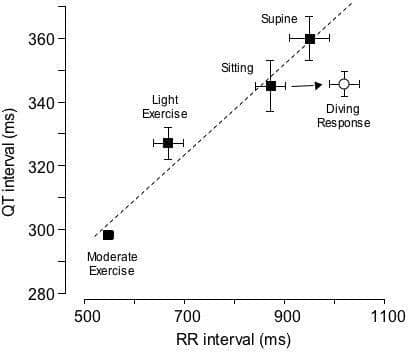The QT interval of the electrocardiogram (ECG) reflects the underlying duration of the ventricular action potential. In most species, including man, as heart rate slows the action potential (and hence QT interval) prolongs and, conversely, on an increase in heart rate, the QT interval shortens. The aim of the present study was to investigate changes in the QT interval during a diving response-induced bradycardia in healthy human subjects. Male (n=10) and female (n=9) subjects aged between 18 and 50 were instrumented with ECG electrodes placed on the right clavicle and lower left margin of the ribs (equivalent to limb lead II). ECGs were digitised (at 1kHz) and recorded using a PowerLab recorder and LabChart Pro 6.0 software (AD Instruments, Australia). Measurements were made under five conditions (i) supine at rest, (ii) sitting at rest, (iii) light exercise, (iv) moderate exercise and (v) during a 30s facial immersion in cold (≈12oC) water with breath-hold. For (i) to (iv) measurements were made after 10min of steady-state recording. Exercise involved cycling on a friction-loaded cycle ergometer. All data are presented as means±SEM (n=10 for males and 9 for females). There were no differences in responses between males and females. In male subjects the RR intervals during light exercise, moderate exercise, sitting and supine were: 668±30, 547±10, 872±30 and 950±40ms. QT intervals were respectively 327±5, 298±1, 345±8 and 360±7ms and all fell on a straight line described by QT (ms) = (0.14*RR)+225 (see figure). However, during bradycardia induced by the diving response (30s), the QT interval did not prolong (in males, Diving Response RR=1018±30 and QT=346±4ms) (see figure). Since the QT interval was measured under non-steady state conditions after only 30s of facial immersion, the failure of the QT interval to adjust to the prevailing slower heart rate could be due to the slow time-constant of the QT response to an abrupt heart rate change(1). Lau et al (1) have described fast and slow components of the QT response to a rapid change in heart rate. However, their data would predict that changes in heart rate equivalent to those induced here by 30s facial immersion should prolong the QT interval by approximately 80ms. Possible other explanations include the co-activation of parasympathetic and sympathetic limbs of the autonomic nervous system to simultaneously slow heart rate while preventing QT prolongation(2). The mechanism underlying this phenomenon requires further investigation, however, it is clear that a failure of the QT interval to match a prevailing diastolic interval during facial immersion would leave the heart vulnerable to re-entrant arrhythmias and, for example, may contribute to the dangers of swimming and diving as known triggers for lethal arrhythmias in genetically-vulnerable individuals(3).
King's College London (2009) Proc Physiol Soc 14, PC27
Poster Communications: Failure of the QT interval of the electrocardiogram to prolong during a diving response-induced bradycardia in human subjects
G. Wong1, J. E. Clark1, M. J. Shattock1
1. Cardiovascular Division, King's College London, London, United Kingdom.
View other abstracts by:
Relationship between the QT interval of the ECG and prevailing heart rate (RR interval) in healthy male subjects during mild and moderate exercise while sitting supine or after 30s of facial immersion with apnoea (Diving Response). Data are expressed as means±SEM (n=10) and r2 for the regression line (see text) is 0.9592.
Where applicable, experiments conform with Society ethical requirements.

